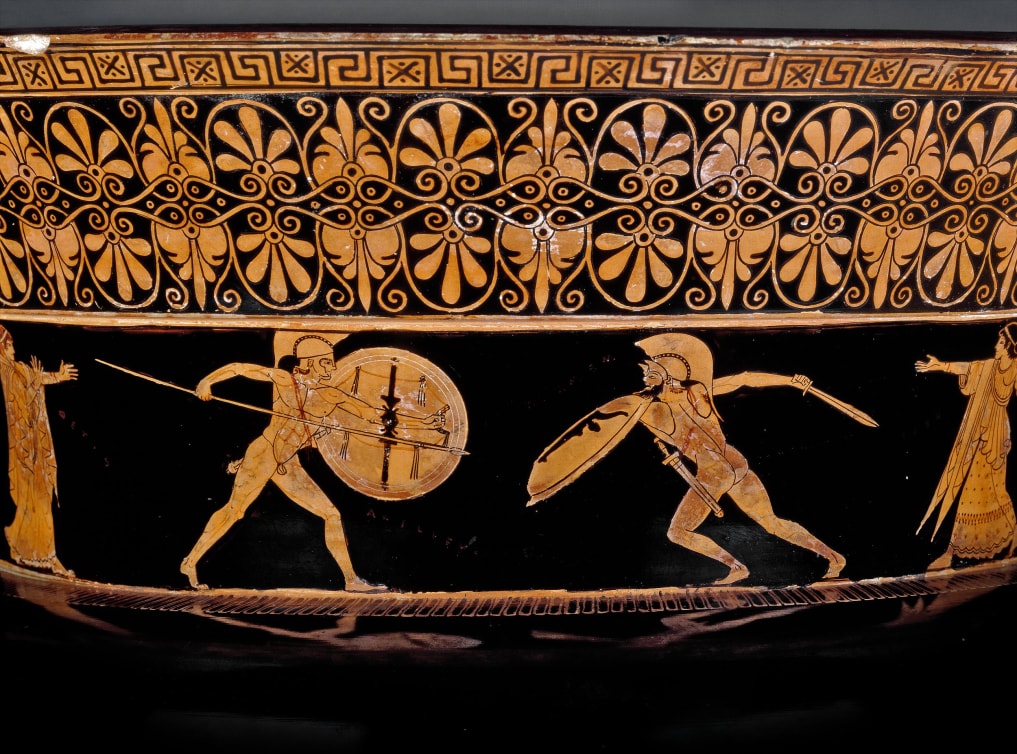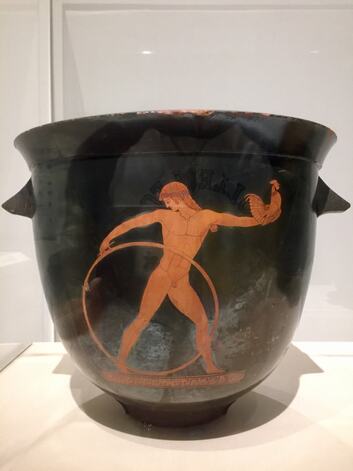|
Where: Room 15 of Level 0 of the British Museum
When: Probably between 490 BC and 460 BC What do you see? A monumental vase with two mythological scenes painted on the upper part, the neck. The vase is a masterpiece of the red-figure technique and one of the iconic examples of Athenian pottery. The shape of this vase is called a volute krater (named after the spiral handles resembling the volutes of the Ionian columns).
Background: This vase is one of the early works of the Berlin Painter. Carol Moon Cardon situates it in the second group of vases from his early period, falling between 500-490 B.C. The timeframes are often tentative, depending on the source or criteria by which scholars assign them. More generally, its place in art history falls into the Late Archaic period (circa 500 to 470 B.C.) There are four preserved volute kraters by the Berlin Painter, all in the red-figure technique. The London krater is unique for a variety of reasons; its architectural design resembling the temple is among the most prominent of those. The fact that the painter decided to leave the entire belly of the vase black while placing the narrative and ornamentation on its extremes speaks of his highly sophisticated approach to design and the interpretative role he attached to imagery.
Red-figure technique: The red-figure painting technique appeared in Athens around 520 B.C. in what is known as the Pioneers’ Group—possibly the longest lasting and most influential red-figure workshop known. The Berlin Painter was possibly the student of one of the three most important of the Pioneers, Phintias. Prior to that, until about the second half of the sixth century B.C., the world of the vase painting was dominated by the black-figure technique.
The red-figure technique was actually simpler than the black-figure technique. The main principle in both was the skillful regulation of the flame and oxygen flow through the oven where the vases were fired to assure the proper oxidization of iron, which, in turn, allowed the painter to achieve the desired color. The black-figure technique rested, in principle, on adding varnish to the pre-contoured shapes on the surface of the vase to create fully developed objects and figures, which turned black upon firing; the red-figure technique was the reversal of the process. Who is the Berlin Painter? Very little is known about the Berlin Painter in terms of the biographical information. It was not common for the vase painters to sign their names at that time. Interestingly, the Berlin Painter inscribed the names of his characters on the London krater. And yet, we do not even know his real name since none of the works attributed to him indicates it. The nickname “The Berlin Painter” was given to him by the prolific scholar, Sir John Beazley, who attributed the makers of some 30 thousand items of Athenian ceramics. The nickname is based on the amphora located in Antikensammlung in Berlin, excavated in the Etruscan city, Vulci. This amphora served as the “mother-work” of the Berlin Painter--the vase to which other found works and fragments were compared in terms of stylistic details, resulting in matching them to the hands of one maker. Some of the stylistic details of the Berlin Painter, which revolutionized the red-figure technique, include:
What we know about him as a person, we can only guess from the themes he chose for his imagery; he was fond of animals and nature, probably liked poetry and city festivals and, of course, gave homage to the gods. He avoided the otherwise common themes of bloody combats and gory scenes, or those of debauchery and drunkenness. Even his depictions of satyrs seemed to emphasize their human nature over the animalistic. The Berlin Painter just seems like a mellow, content man. Other works by The Berlin Painter: In 1911, Beazley assigned 38 vases to the Berlin Painter (“master of the Berlin amphora”) and outlined the characteristics of the Berlin Painter’s renderings. His drawing style was described in 1922 and by 1925 there were already 148 vases attributed to the artist. As of today, over 400 works of pottery and fragments are attributed to the Berlin Painter. Because of their masterful artistry, they are highly appreciated and sought by the world’s museums. In the Gregorian Etruscan Museum in the Vatican Museums, there is the beautiful hydria with Apollo sitting on the winged tripod, playing the lyre, as two dolphins below make their way back into waters. The Metropolitan Museum of Art has 13 vessels. Among them is another hydria, featuring Achilles slaying Penthesilea, the queen of the Amazons. This museum has arguably one of the most exquisite of all vases by the Berlin Painter, the type C amphora with the beautiful walking-singing citharode—youth playing the kithara—on one side and the contest judge on the other side. The Louvre has the largest collection of his vases, for a total of 36. The only cup known to be painted by this artist (although debates over the attribution continue) is in the Agora Museum in Athens. It is called the Gorgos Cup, after the potter Gorgos, who provided the vessel to be decorated. The name "Gorgos" as the maker of the vessel is inscribed on the cup. While some painters were also potters of the vases they worked with (and it is possible the Berlin Painter was among them in some instances), the transition from potter to painter was not at all automatic. There are also the Panathenaic amphorae painted by the Berlin Painter. Those were the vases that were filled with olive oil and given as prizes to winners of the Panathenaic Games. They were always traditionally done in the black-figure technique. Only highly esteemed painters were commissioned to provide those. Out of 21 vases painted by the Berlin Painter in the black-figure technique, possibly only two are not the Panathenaic amphorae (a fragmented amphora Type A in New York and a hydria in Frankfurt). While vases, in general, were popular in antiquity and were given as burial offerings to go with the departed close ones, only the wealthy could afford to have a vase decorated by, say, the Berlin Painter or other artists of high esteem. The amphorae given to victors of the games were a sign of the prestige of the artist whom they were commissioned to.
Legacy: There were three immediate students of the Berlin Painter, who were all very important and painted a large number of vessels: The Providence Painter, Hermonax and The Achilles Painter. The last of them, along with his own student, the Phiale Painter, closed the workshop of the Berlin Painter in 425. Although the workshop closed, many features of the Berlin Painter’s innovative style remained with generations of vase painters.
The students of the Berlin Painter and other followers who came even later into the vase painting world (the Harrow Painter, the Tithonos Painter, the Painter of the Yale Lekythos, Alkimachos Painter, just to name a few) carried on the legacy of the master by either adopting his ornamentation style, features of the design (the “less is more” on the vase), or took up shapes which were not popular among the red-figure artists before the Berlin Painter. The Berlin Painter was not only the master of the already existing technique but developed it as well as expanded the repertoire of shapes which began to be painted in the red-figure technique. He was not just the master of his technique but a thinker and inventor.
3 Comments
|
Categories
All
|
- Home
- Blog
-
Museums
- Alte Pinakothek
- Art Institute of Chicago
- Baltimore Museum of Art
- Barber Institute of Fine Arts
- Bargello
- Barnes Foundation
- British Museum
- Church of Sant’Anastasia
- Cleveland Museum of Art
- Courtauld Institute of Art
- Detroit Institute of Arts
- Frans Hals Museum
- Galleria Borghese
- Gallerie dell'Accademia
- Getty Museum
- Guggenheim
- Hermitage Museum
- Kunsthistorisches Museum
- Kunstmuseum Basel
- Legion of Honor Museum
- Louvre
- Mauritshuis
- Metropolitan Museum of Art
- Musee d’Orsay
- Museum of Fine Arts in Boston
- Museum of Modern Art
- National Gallery in London
- National Gallery of Art
- National Museum in Poznań
- Norton Simon Museum
- Ny Carlsberg Glyptotek
- Palace of Versailles
- Palazzo Pitti
- Palazzo Vecchio
- Petit Palais
- Philadelphia Museum of Art
- Prado
- Pushkin Museum
- Ravenna Art Museum
- Rijksmuseum
- San Diego Museum of Art
- Santa Maria delle Grazie
- St. Peter's Basilica
- Städel Museum
- Statens Museum for Kunst
- Tate Britain
- Tate Modern
- Timken Museum of Art
- Uffizi
- Vatican Museums
- Wallace Collection
-
Artists
- Altdorfer
- Anguissola
- Berlin Painter
- Bosch
- Botticelli
- Boucher
- Bronzino
- Bruegel the Elder
- Brunelleschi
- Cabanel
- Caillebotte
- Canova
- Caravaggio
- Carpeaux
- Cezanne
- Cimabue
- David
- Degas
- Delacroix
- De Maria
- Donatello
- El Greco
- Fontana
- Fra Angelico
- Fragonard
- Gauguin
- Gentileschi
- Gericault
- Gonzalez-Torres
- Goya
- Hals
- Hogarth
- Hokusai
- Ingres
- Leonardo da Vinci
- Lippi, Filippo
- Longhi, Barbara
- Lorrain
- Makovsky
- Manet
- Massys
- Matisse
- Merian
- Michelangelo
- Mochi
- Modigliani
- Monet
- Panini
- Parmigianino
- Perugino
- Picasso
- Pisanello
- Raphael
- Rembrandt
- Renoir
- Reynolds
- Rivera
- Rodin
- Rubens
- Scultori
- Seurat
- Steen
- Tintoretto
- Titian
- Toulouse-Lautrec
- Turner
- Uccello
- Van der Weyden
- Van Dyck
- Van Eyck
- Van Gogh
- Van Hemessen
- Vasari
- Velazquez
- Vermeer
- Veronese
- Vigée Le Brun
-
Locations
- Books
- About Us






